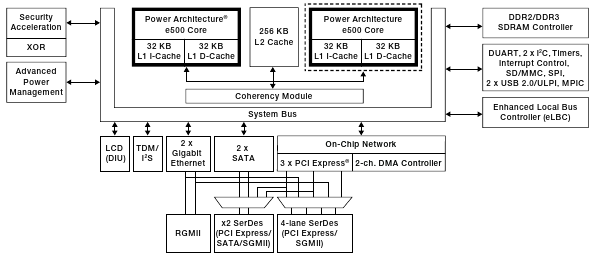A1222 Guide: IntroductionWhy would anyone want the A1222? The forums say it's crippled!Ever since it was announced the Amiga forums have been flooded with trolls, I mean, experts, suggesting that the A1222 is dead on arrival. It has a crippled CPU. There won't be drivers. It will be a compatibility nightmare. Trevor Dickinson is the devil, and Matthew Leaman is his hellish minion. It's been a bit much. So let's set the record straight. I've been using my A1222 for a very, very long time, and while it's not the X5000, it is way faster and more usable than my old SAM440ep -- the last next-generation Amiga system that came in a Mini-ITX form factor. I really enjoy mine, and I've collected the following tidbits to help those of you who decided to take the plunge. The elephant in the room is the choice of processor A-EON made: the NXP P1022. On the surface it seems a reasonable choice. It has two 1GHz cores, support for DDR3 ECC DIMMs, support for SATA2, two four-channel DMA controllers, accelerated Ethernet, and even an on-board LCD interface. Sounds great. But there is a huge catch: the two e500v2 cores on the chip lack the 'normal' FPU found in most PowerPC designs. Instead it has an 'SPE' which, among other things, executes floating-point instructions and uses the regular CPU GPRs for its data. The net of all this means that existing software that uses floating-point instructions or data will not work out of the box.  That's a big deal. It wasn't in the 1980s, or even the early 1990s, when Commodore shipped several Amiga systems without a FPU. If we had a 68000, 68020, or 68030 (without the 68882 FPU chip), we just selected the non-FPU binary of our software and moved on. But floating-point mathematics is used in a ton of places today, especially in 3D graphics. So if the FPU isn't compatible, does that mean all that software is broken? No, but there's a catch. Just like during the transition that AmigaOS made from Motorola 68K processors to the PowerPC family, emulation is used to allow the A1222 to run software that was compiled for the traditional PowerPC ABI to run on the P1022 processor. In fact there are two emulators: a normal interpretative emulator -- where each instruction is executed one by one on the SPE, copying and restoring register data each time -- and a load-time emulator, where when you launch your program containing floating-point instructions, it does the translation as it's loading the binary into memory. The former is more compatible, the latter is faster. To be sure a real FPU is on the order of 20X faster than even the LTE emulation layer, but it works, and unless you're running something that is doing nothing but floating-point instructions, it will work quite nicely. For older 68K software the emulated 'FPU' is faster than what you'd get on a 060 anyway. This does mean that if you want to do things like 3D rendering or first-person shooter games the A1222 is probably not for you; for everything else using the FPU occasionally, it should be 'good enough' to where you'll be happy. Be sure to peruse the compatibility lists (applications, games) in this guide, though, before you buy.  As for driver support everything on the board is supported. On-board audio works, as does SATA, USB2, the on-die Ethernet controllers, and even the LCD interface -- although the HW is fairly limited; you'll still want to be running with a nice RadeonRX graphics card. And the compatibility with everything currently available for AOS4, while not perfect, is much better than people imagined. If you want to see a live demonstration showing what the A1222 can do and how well, check out my AmiWest 2021 presentation on YouTube. Oh, and as for Trevor or Matthew being evil, well, no one is perfect. ;-) So why choose the P1022 in the first instance?! There has been a lot of kerfuffle about why on Earth someone would choose an incompatible CPU as the basis for any system, let alone one aimed to appeal to new next-generation Amiga users given the supposed complexity they'll encounter. I have no actual knowledge as to why that design decision was taken, but I do have a theory. You have to go back to the beginning of A-EON and the creation of the AmigaOne X1000. This was designed to be the great comeback, the new high-end Amiga that would help restore the fortunes of the AmigaOS platform. Among other things it was based around the exotic PA-Semi PA6T, which not only offered terrific performance, but was unusual enough to get the system attention by itself. Unfortunately after Apple's acquisition of PA-Semi they decided not to honor the order Varisys had placed and upon which the entire project rested. At this point A-EON is literally trying to get Steve Jobs to intervene and save the project. After initially saying a terse 'no,' Varisys were able to secure the remaining PA6Ts -- at huge cost. A-EON was now going to end up losing money on every sale, the project ended up being delayed, and there was no support from the CPU vendor. What a nightmare. The fact that Trevor and Matthew followed through for the community in spite of this shows their excellent caliber -- especially when compared to the various grifters the Amiga scene has seen over the years. So when the idea comes to design a low-cost, entry-level board, the last thing A-EON would want is a repeat of the previous debacle with the X1000. Low-cost, reasonably performing PowerPC SoCs weren't terribly abundant at the time, the upcoming QorIQ T10xx series was still being developed, and Freescale wasn't committing to long-term support for them just yet. But the P1022 was cheap, available in bulk, and came with a long-term, 10+ year support guarantee. In the early 2010s, it made sense, especially when core OS developers had said there was a software solution they could implement to handle the lack of a compatible FPU. They even ended up writing two different emulation layers to run legacy software as best as possible. Things have changed immensely in both the general computing arena, and the Amiga scene since the A1222 was originally designed. The 68K part of the community has exploded with interest as middle-aged folks with fond memories of the 1980s and 1990s have sunk funds into recreations like the A500 Mini to relive their gaming past. The A1222 could have been a big hit if available, but development stalled for so long the board had to undergo revisions because basic components became end-of-life or otherwise unavailable. That's why customers will be technically be purchasing an "A1222 Plus" rather than just an A1222. There are no new features to the board, but it cost yet more time to market and more development cost to amortize across the life of the product.  The irony is that had A-EON delayed Tabor's development just a few years more, the T1022 would have been available in bulk. It wouldn't have had the SPE vs FPU issue, and would have been faster as well. The forums love to point this out. But at the time no one knew that it would take anywhere near as long as it has to get the A1222 to consumers. Hindsight is always 20-20, and it's easy to armchair quarterback, especially when you're an anonymous nobody on some random forum posting from your mother's ill-lit basement. As I'll mention again and again in this guide, the best judge of reality is you. Watch Youtube videos, go to your local Amiga dealer, head to a user group or Amiga show and try the A1222+ yourself. I really like mine, and there will be others like me. Some will not like its limitations and would probably prefer a SAM460 or Vampire or something. Don't listen to the online geniuses -- only you know what will be fun for you. That's what the Amiga is supposed to be: fun! 


Introduction | Initial Build | Disk Options | Recommended Software Tools Compatibility | Games Compatibility | Tips | Benchmarks | FAQ | Links Last updated: 16.12.23 |